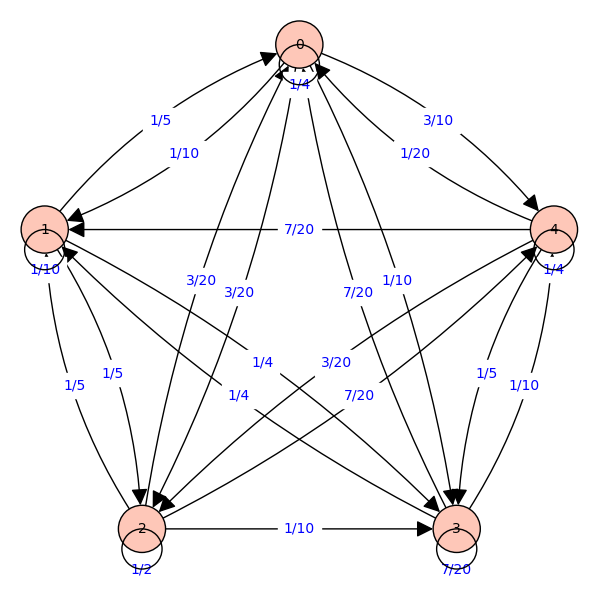Now suppose a company is running this taxi services and has certain number of taxies. The above proportation of distribution has been otained from some past experience. Suppose the comany has a total,
\(N\) taxies and wish to find out how many taxies he/she should place at various location so that his business runs smoothly. How to formulate this problem?
Suppose \(x_i\) denotes the number of taxies to be kept at the locatio \(i\text{.}\) Then we have
\begin{equation*}
x_0+x_1+x_2+x_3+x_4=N.
\end{equation*}
How many taxies will be there at the location \(0\) after one day. It is easy to see that it is
\begin{equation*}
1/4x_0 + 1/10x_1 + 3/20x_2 + 1/10x_3 + 3/10x_4.
\end{equation*}
Similarly the number of taxies at various locations are as follows:
-
Location 1:
\(1/5x_0 + 1/10x_1 + 1/5x_2 + 1/4x_3\)
-
Location 2:
\(3/20x_0 + 1/5x_1 + 1/2x_2 + 1/10x_3 + 7/20x_4\)
-
Location 3:
\(7/20x_0 + 1/4x_1 + 7/20x_3 + 1/10x_4\)
-
Location 4:
\(1/20x_0 + 7/20x_1 + 3/20x_2 + 1/5x_3 + 1/4x_4\text{.}\)
Ideally, the company would want the same number of taxies to come back at each location everyday. How to find these \(x_i's\text{?}\) It is easy to see that this amount to solving the following system of linear equations
\begin{align*}
1/4x_0 + 1/10x_1 + 3/20x_2 + 1/10x_3 + 3/10x_4\amp =\amp x_0\\
1/5x_0 + 1/10x_1 + 1/5x_2 + 1/4x_3\amp =\amp x_1\\
3/20x_0 + 1/5x_1 + 1/2x_2 + 1/10x_3 + 7/20x_4 \amp =\amp x_1\\
7/20x_0 + 1/4x_1 + 7/20x_3 + 1/10x_4\amp= \amp x_3\\
1/20x_0 + 7/20x_1 + 3/20x_2 + 1/5x_3 + 1/4x_4\amp =\amp x_4
\end{align*}
The above equations can be written in a matrix form as follows:
\begin{equation*}
\left(\begin{array}{rrrrr}
\frac{1}{4} \, x_{0} + \frac{1}{10} \, x_{1} + \frac{3}{20} \, x_{2} + \frac{1}{10} \, x_{3} + \frac{3}{10} \, x_{4} \\
\frac{1}{5} \, x_{0} + \frac{1}{10} \, x_{1} + \frac{1}{5} \, x_{2} + \frac{1}{4} \, x_{3} \\
\frac{3}{20} \, x_{0} + \frac{1}{5} \, x_{1} + \frac{1}{2} \, x_{2} + \frac{1}{10} \, x_{3} + \frac{7}{20} \, x_{4} \\
\frac{7}{20} \, x_{0} + \frac{1}{4} \, x_{1} + \frac{7}{20} \, x_{3} + \frac{1}{10} \, x_{4} \\
\frac{1}{20} \, x_{0} + \frac{7}{20} \, x_{1} + \frac{3}{20} \, x_{2} + \frac{1}{5} \, x_{3} + \frac{1}{4} \, x_{4}
\end{array}\right) =
\left(\begin{array}{rrrrr}
x_{0} \\ x_{1} \\ x_{2} \\ x_{3} \\x_{4}
\end{array}\right).
\end{equation*}
The above equation can be written as
\begin{equation*}
\left(\begin{array}{rrrrr}
\frac{1}{4} \amp \frac{1}{10} \amp \frac{3}{20} \amp \frac{1}{10} \amp \frac{3}{10} \\
\frac{1}{5} \amp \frac{1}{10} \amp \frac{1}{5} \amp \frac{1}{4} \amp 0 \\
\frac{3}{20} \amp \frac{1}{5} \amp \frac{1}{2} \amp \frac{1}{10} \amp \frac{7}{20} \\
\frac{7}{20} \amp \frac{1}{4} \amp 0 \amp \frac{7}{20} \amp \frac{1}{10} \\
\frac{1}{20} \amp \frac{7}{20} \amp \frac{3}{20} \amp \frac{1}{5} \amp \frac{1}{4}
\end{array}\right)
\left(\begin{array}{rrrrr}
x_{0} \\ x_{1} \\ x_{2} \\ x_{3} \\x_{4}
\end{array}\right)=\left(\begin{array}{rrrrr}
x_{0} \\ x_{1} \\ x_{2} \\ x_{3} \\x_{4}
\end{array}\right).
\end{equation*}
We can write it in compact form as \(AX=X\) where
\begin{equation*}
A = \left(\begin{array}{rrrrr}
\frac{1}{4} \amp \frac{1}{10} \amp \frac{3}{20} \amp \frac{1}{10} \amp \frac{3}{10} \\
\frac{1}{5} \amp \frac{1}{10} \amp \frac{1}{5} \amp \frac{1}{4} \amp 0 \\
\frac{3}{20} \amp \frac{1}{5} \amp \frac{1}{2} \amp \frac{1}{10} \amp \frac{7}{20} \\
\frac{7}{20} \amp \frac{1}{4} \amp 0 \amp \frac{7}{20} \amp \frac{1}{10} \\
\frac{1}{20} \amp \frac{7}{20} \amp \frac{3}{20} \amp \frac{1}{5} \amp \frac{1}{4}
\end{array}\right)
\quad \text{and} \quad X=\left(\begin{array}{rrrrr}
x_{0} \\ x_{1} \\ x_{2} \\ x_{3} \\x_{4}
\end{array}\right).
\end{equation*}

